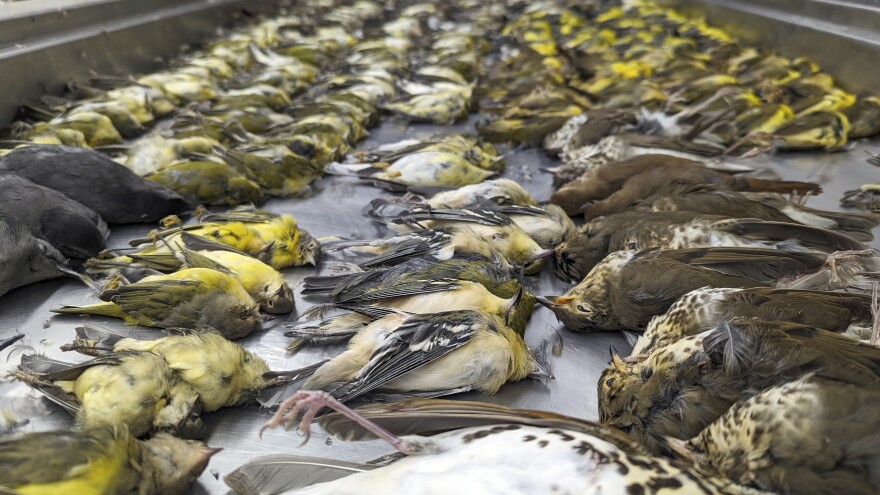Nearly 1,000 birds died late last week after flying into a Chicago convention center during their migratory journey south.
964 birds crashed into McCormick Place Lakeside Center, a mostly glass building located on the shore of Lake Michigan just south of downtown Chicago.
Douglas Stotz, a conservation ecologist with the Chicago-based Field Museum, called Wednesday evening the biggest night of migration Chicago had seen in the last century.
"In one night we had a year's worth of death," he told NPR, noting that typically, between 1,000 and 2,000 birds die each year from flying into the building.
The Field Museum monitors the building for dead or injured birds.
Before getting to work on Thursday morning, Stotz saw what he described as "clouds of birds" in the sky.
"We check McCormick Place daily during migration to pick up dead birds and to release ones that are still alive," he said. "When I went into the museum, it was way beyond what I could have imagined."
He said the previous number of birds killed in a single day flying into the convention center was close to 200 to 300 birds.
"The well-being of migratory birds is of high importance to us, and we are truly saddened by the incident," the convention center wrote in a statement posted to Instagram.

While millions of birds fly over the Windy City during fall and spring migrations, a confluence of specific conditions contributed to the unprecedented migratory event last week.
"October is always one of our busiest times of year," Annette Prince, the director of Chicago Bird Collision Monitors, told NPR.
During the days leading up to the influx of birds flying over Chicago, birds hadn't been traveling "because weather conditions were not favorable," said Prince, who noted recent winds from the south prevented birds from moving through the city.
"Birds like to fly in the fall when there is a north or a west wind because they're coming from areas north of us, and that gives them a literal and figurative tailwind to travel with," said Prince.
Additionally, a storm south of Chicago forced birds to fly closer to the ground, said Stotz.
"Birds don't really want to fly into those storms," he said.
Dead birds were found throughout the downtown area after this intense two days of migration.
The Smithsonian Conservation Biology Institute and the U.S. Fish and Wildlife Service estimate hundreds of millions of birds are killed annually in the United States due to building collisions.
Light reduction, especially during key migratory times, can reduce the number of birds that die when flying through urban areas.
"It would have made a huge difference to have the lights off," Stotz said, noting McCormick Place was aglow last week.
"Lighting at McCormick Place is turned off unless needed for our employees, clients, or visitors," the convention center said in its statement. "It is important to understand that there is an event going on at Lakeside Center this week, and thus the lights have been on when the space is occupied."
Chicago's voluntary Lights Out program asks that tall buildings turn their lights out after 11p.m. every night until daylight during spring and fall migration dates. Stotz said most buildings downtown participate in the program, although "sometimes forget that they should be turning out the lights."
McCormick Place said it participates in that program, "which has helped reduce the number of bird collisions on campus by 80%."
A 2021 study determined that decreasing the number of lit windows at McCormick Place could cut fatal bird collisions by around 60%. Management of the building "should be fully aware they are in a key location where it behooves them to take a serious participation in the lights out program," Prince told NPR.
Still, Stotz said the Field Museum, along with other conservation organizations in Chicago, have urged McCormick Place to participate in the Lights Out program more consistently, but continue to get the same answer — that it's up to the client whether or not the lights are turned off.
He added it's not just McCormick Place that's the issue.
"This is a long, ongoing problem," Stotz said.
Copyright 2023 NPR. To see more, visit https://www.npr.org.




